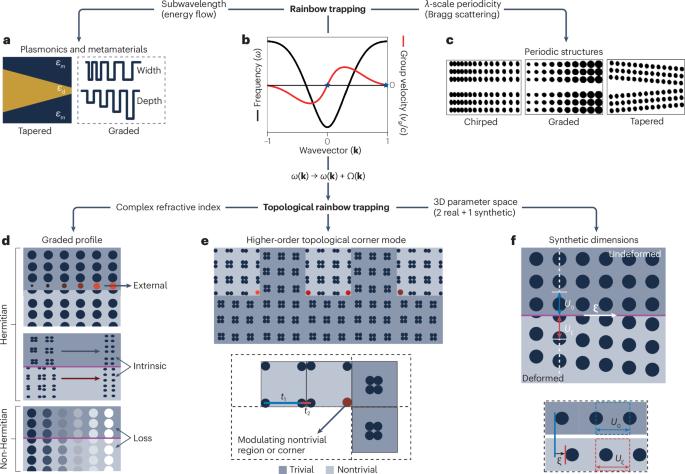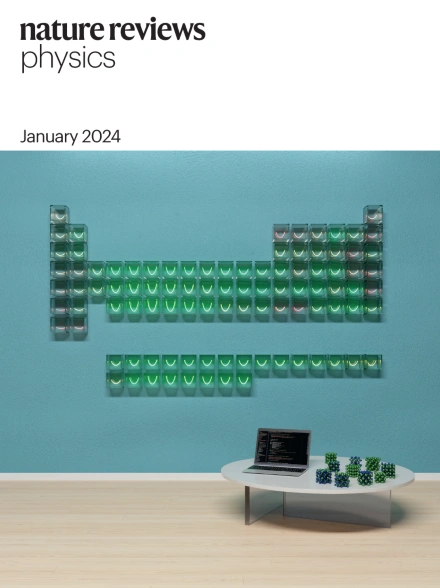Topological rainbow trapping
IF 39.5
1区 物理与天体物理
Q1 PHYSICS, APPLIED
引用次数: 0
Abstract
Topological rainbow trapping (TRT) arises from the interplay between topological states and frequency-dependent slow-wave effects. Waves first slow down, then become spatially separated by frequency and are ultimately trapped at distinct locations. TRT designs have been primarily explored in the context of photonic crystals and subsequently extended to acoustic and elastic systems. This emerging TRT concept enables robust, frequency-selective localization beyond conventional rainbow trapping, supporting compact, multi-wavelength, topologically protected platforms for extreme wave manipulation. In this Review, we elucidate the fundamental principles of TRT, emphasizing the physical mechanisms that create near-zero group velocity points with robust frequency-dependent localization. We highlight three key TRT mechanisms: graded index profiles, which gradually vary material parameters to reshape dispersion and induce slow-wave effects; higher-order topological corner modes, which exploit localized corner states for robust frequency-specific wave confinement; and synthetic dimensions, which expand the parameter space of the system to engineer stable interface states at distinct frequencies. Furthermore, we address key challenges in TRT, such as energy dissipation and tunability, while highlighting its broad range of potential applications. Finally, we discuss emerging research directions for TRT. Topological rainbow trapping combines slow-wave effects with topological robustness to spatially separate wave frequencies. This Review highlights its physical principles, implementation in different waves-based systems and potential technological impacts.

拓扑彩虹诱捕
拓扑彩虹捕获(TRT)是拓扑态与频率相关慢波效应相互作用的结果。波首先变慢,然后在空间上被频率分开,最终被困在不同的位置。TRT设计主要在光子晶体的背景下进行探索,随后扩展到声学和弹性系统。这种新兴的TRT概念实现了传统彩虹捕获之外的鲁棒、频率选择性定位,支持紧凑、多波长、拓扑保护的平台,用于极端波操作。在这篇综述中,我们阐明了TRT的基本原理,强调了创建具有鲁棒频率相关定位的近零群速度点的物理机制。我们强调了三个关键的TRT机制:渐变指数分布,它逐渐改变材料参数以重塑色散并诱导慢波效应;高阶拓扑角模,利用局域角态实现鲁棒的频率特定波约束;扩展了系统的参数空间,从而在不同频率下设计出稳定的界面状态。此外,我们解决了TRT中的关键挑战,如能量耗散和可调性,同时强调了其广泛的潜在应用。最后,我们讨论了TRT的新兴研究方向。拓扑彩虹捕获结合了慢波效应和拓扑鲁棒性对空间分离的波频率。本综述重点介绍了其物理原理、在不同波基系统中的应用以及潜在的技术影响。
本文章由计算机程序翻译,如有差异,请以英文原文为准。
求助全文
约1分钟内获得全文
求助全文
来源期刊

Nature Reviews Physics
Multiple-
CiteScore
47.80
自引率
0.50%
发文量
122
期刊介绍:
Nature Reviews Physics is an online-only reviews journal, part of the Nature Reviews portfolio of journals. It publishes high-quality technical reference, review, and commentary articles in all areas of fundamental and applied physics. The journal offers a range of content types, including Reviews, Perspectives, Roadmaps, Technical Reviews, Expert Recommendations, Comments, Editorials, Research Highlights, Features, and News & Views, which cover significant advances in the field and topical issues. Nature Reviews Physics is published monthly from January 2019 and does not have external, academic editors. Instead, all editorial decisions are made by a dedicated team of full-time professional editors.
 求助内容:
求助内容: 应助结果提醒方式:
应助结果提醒方式:


